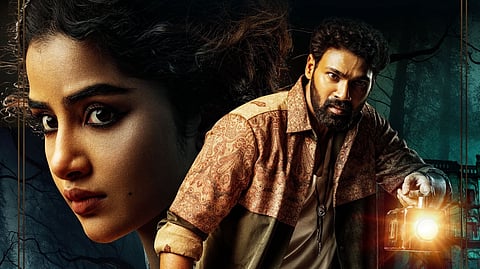Kishkindhapuri Movie Review: Many surprises await in this cinematically curious thriller
Kishkindhapuri(3 / 5)
The relationship between mainstream Telugu cinema and a larger-than-life intro scene for the ‘hero figure’ is seemingly undying, no matter what the genre is. So when, after being promoted as a high-concept mystery-thriller, Kishkindhapuri makes space for a stereotypical ‘he-has-arrived’ set piece for Bellamkonda Sreenivas, you can’t help but twitch in your seat a little. However, something stands apart this time — amidst all the stunts and bravado, there is a novel visual device here that remains the highlight and keeps the proceedings interesting. By the end of the scene, we learn (and are told) about Raghav’s compassion towards every living being, not just people. For him, saving lives is beyond proving his machismo. Koushik Pegallapati’s sophomore film Kishkindhapuri largely runs on this principle and there are a handful of cliches and tropes, but there are even more attempts to do something different, and the film succeeds to a great extent.
Cast: Anupama Parameswaran, Bellamkonda Sreenivas, Hyper Aadi, Tanikella Bharani
Director: Koushik Pegallapati
There are a few awkward decisions in the early portions — the prologue, while admirable in its visual ideas (a talking radio, a killer insect) feels a little overbearing in its treatment. The initial attempts at humour (courtesy of Hyper Aadi’s character, mostly) befuddle you. There is a dream song sequence that belongs to the 90s. And yet, despite an awkwardly set up premise, Kishkindhapuri somehow settles down fine into a narrative filled with plenty of intrigue and thrills. The film finds a unique backdrop — a haunted radio station — and knows how to play around it. There are some convenient devices later on, but there is also a lot of conviction at work here. Koushik Pegallapati maintains a fine balance of intensity and kitsch on a writing level, as Raghav and Maithili find themselves deeper down a tale from the past that’s the cause of their woes. The writers (Koushik in collaboration with Bala Ganesh K and Darahas Palakollu) also push you against the wall with a few sequences, showing a desire to shock the viewer with the horrifying possibilities in this universe where even a child could be a brutal victim of a demon.
Even though there are a few occasional jumpscares, Kishkindhapuri cannot be labelled as a horror film per se. In fact, the film deftly navigates many genres without stumbling on its way. You know the conviction is impactful when the director incorporates an intense song in a pre-climactic sequence — very rare for a horror-based narrative — and it fits in very well without hampering the pace or losing the tension. The film is most impressive with its knack for visual styling that ensures the storytelling remains engaging on a sensory level. Some of the scenes might be familiar, but the way they are staged and merge into each other is what holds your attention (special mention to cinematographer Chinmay Salaskar and editor Niranjan Devaramane). Sam CS’s background score too elevates the narrative with its inclination towards finding newer sounds.
While the third act falls into a familiar territory (with a lot of mumbo-jumbo about divine forces and magical stones), there are also fine little surprises at regular intervals, including an elaborate flashback sequence that establishes a new layer to the narrative. Demons with a tragic past are not a unique phenomenon, but here, the flashback track adds an element of emotional trauma to the evil force, who too was once a simple living being, just longing to be heard and accepted. Both the actors in the flashback portions are tremendous in the way they help us empathise with the character. The film is at its most impressive in these portions, where you unravel the past while remaining hooked to the present.
Bellamkonda Sreenivas, playing Raghav, a noble-hearted man who eventually has to step up as the saviour, does his best to shoulder the narrative but comes up short. On the other hand, despite being handed a relatively less significant part, Anupama Parmeswaran lends a certain larky quality to Maithali (particularly in the post-interval portions) that a genre like this usually demands. Tanikella Bharani is impressive in his brief cameo.
Kishkindhapuri’s ambitions also reflect in its attempt to incorporate a VFX-driven visual landscape as a coherent part of its narrative, despite being a mid-scale film. When Raghav finds himself pulled down in a psychological hell after battling his fears for the longest time, Koushik Pegallapati displays great sincerity on an execution level. While the quality of these CGI portions themselves could be a hit and miss, what’s unmistakable is the director’s clear vision. In these times when Indian filmmakers are increasingly competing with world cinema for their audience’s attention, especially when it comes to films driven by visual spectacle, it’s important that we give a slight benefit of the doubt to those films that might be constrained in their resources, but not in their ambition. Kishkindhapuri is one of those sincere attempts.


